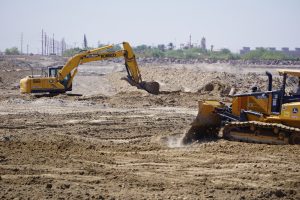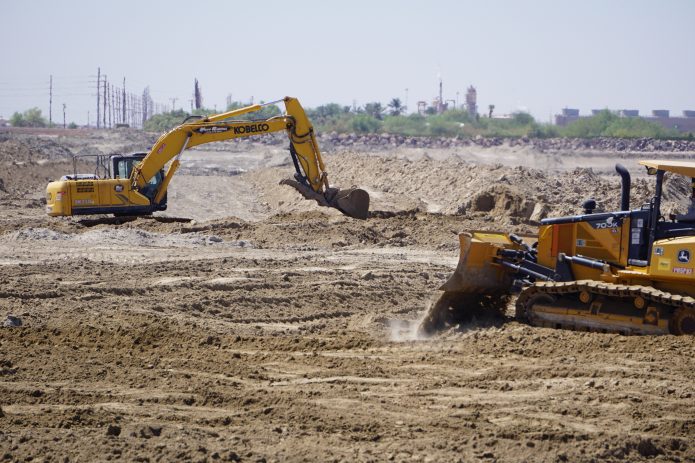
Tractors build the earthen berms recently for the Red Hill Marina wetlands project at the Salton Sea. Work has resumed on the wetlands, which will cover as much as 530 acres of exposed playa. The Red Hill Marina wetlands is one of the projects included in the State’s Salton Sea Management Program Phase 1 10-year Plan, which could receive a $200 million boost from a proposed water and parks bond.
Votes by the State Senate and Assembly on Friday, Sept. 15, in support of a $4 billion water and park bond includes $200 million for the Salton Sea—not quite as much as stakeholders would have liked to have seen in the bond—but still a significant boost to the State’s Salton Sea Management Program (SSMP) Phase I 10-Year Plan. That is if the bond is approved by voters in 2018. The legislation for the bond, SB 5, is currently in the hands of Gov. Jerry Brown for signature, which would then send it to voters in June 2018.
The action by the Legislature in support of funding for the Salton Sea comes just a little over a week after the San Diego County Water Authority, the Imperial Irrigation District and Imperial County presented a draft Stipulated Order to the State Water Resources Control Board (the Board) that establishes a clear path forward for restoration at the sea. During a public workshop in Sacramento, the Board listened to testimony regarding the draft Stipulated Order, and is expected to vote on the proposed order in the coming months. Praised by Bruce Wilcox, assistant director of California Natural Resources in charge of Salton Sea policy, as a step forward, the proposal by the three agencies represents a critical compromise to jumpstart the State’s work at the Sea.
The SSMP’s Phase I 10-Year Plan, which includes a mix of air quality and habitat projects, comes with a $380 million price tag. To date, the State, as part of a previously voter-approved water bond, has $80 million for phase one. The new water and parks bond—if approved by voters—would increase that by $200 million. Though still $100 million shy of covering all costs, it would be a significant leap forward, allowing projects to move forward as additional funding is sought.
In short, it appears as if the pieces of a puzzle are starting to come together toward a unified effort at the Salton Sea that will address both the immediate air quality and habitat needs and look toward a long-term solution to restoration while ensuring there is proper oversight over the SSMP’s progress. This now potentially includes a large pot of funding, which has hindered progress to date.
But, as had been said before, we all must be vigilant. There are key milestones ahead that must be met, key decisions that must be made, and the all-important vote water bond vote anticipated to come in June. Continue to follow this issue and look to Imperial-San Diego Currents for regular updates.
